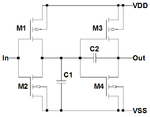CAMALEAO
Full Member level 4
Hi everyone,
I would like to know how both of these concepts relates to each other since from .y understanding, the driver strength is the one who controls the slew rate. This is specially seen on gpios.
From my understanding, if you have a strong driver strength, your slew rate will be high.
Now if you look at some MCUs/FPGAs their gpios slew rate are allowed to be controlled.
But like I mentioned above, the slew rate can be controlled by drive strength for the load. That is, high slew rate, high drive strength for more current.
Then, what's the concept of that slew rate can controlled separately with drive strength? Why there is a choice of slew rate and drive strength together?
Regards.
I would like to know how both of these concepts relates to each other since from .y understanding, the driver strength is the one who controls the slew rate. This is specially seen on gpios.
From my understanding, if you have a strong driver strength, your slew rate will be high.
Now if you look at some MCUs/FPGAs their gpios slew rate are allowed to be controlled.
But like I mentioned above, the slew rate can be controlled by drive strength for the load. That is, high slew rate, high drive strength for more current.
Then, what's the concept of that slew rate can controlled separately with drive strength? Why there is a choice of slew rate and drive strength together?
Regards.
